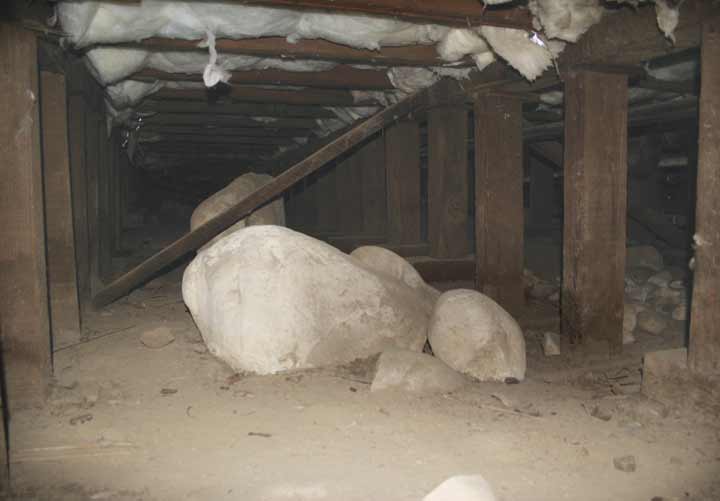
|
A boulder field vies for space with Mill floor supports installed when the structure was built in 1887. The Ventura County Agriculture Museum is upgrading the floor support system to allow the display tractors, which can weigh up to 3 tons each. |
The Mill: VC Agriculture Museum focus of floor support project
November 24, 2010
By Peggy Kelly
Santa Paula News
Trenching and hauling river rock hidden under the historic Mill is underway for floor supports that will withstand hefty vintage farm equipment in the last - and unanticipated step - in preparing the county’s former longest continuous business into the Ventura County Agriculture Museum.
Susan L. Gerrard of the Museum of Ventura County said trenching for the floor support project started November 16 at Mill, located at Railroad Avenue and Mill Street. Excavation material is more than 50 percent river rock - “a boulder field,” noted Gerrard - sharing hidden space with the circa 1887 floor supports under the historic building.
The Mill, now owned by the Ventura County Transportation Commission as part of their branch line holdings, underwent an ambitious $2.6 million renovation to become the home of the new museum. But once the renovation was completed the realization set in that the floor would be inadequate to hold the museum’s vast collection of farm equipment.
The work, according to Agriculture Museum Director Brian Weber, is important, as “The existing floor is fine for normal activity, but when we start rolling in heavy tractors and other farm equipment, the weight load becomes very significant.” Eventually, seven rows of continuous cement footings will be placed along the length of the 12,000-square foot Mill, connected to existing floor joists with stem walls; the project is expected to last 90 days.
Weber said that now at the west end of the Mill “There are a couple of piles, pretty equal dirt and rocks... and then just rocks” the contractor would deal with once the work is completed.
The Mill, over its more than a century of continuous operation, was a barley seed cleaning plant, feed store, general needs store - and those needs often included socializing and barn dancing - then finally a one-of-a-kind mall for antiques and collectibles that also displayed thousands of collected over generations “Who would have thunk it?” items. Generations of the Hengehold family - which took over the Mill in the 1950s - operated the Mill until its closure in 2005.
The Mill was always famous for its eclectic collections, including a stuffed horse that oversaw the store and its patrons for decades. But Weber said, “Some old things of interest” have been uncovered during initial trenching, notably the vintage wine and whiskey bottles “we seem to find all around this place.”
Weber stressed that although the floor support is due to the weight of farming equipment that will be displayed, “It’s not a tractor museum; but they are intrinsically a part of the museum and we will be highlighting them... and one of our shows will be about tractors. We have to be prepared for that.”
And “that” is plenty: although “It’s hard to say,” Weber estimates the average weight of such a tractor is in to the 2- to 3-ton range, up to 6,000 pounds each. “It could be less weight than that, but it will all be concentrated in four by eight foot sections; if you just had people standing there that would be fine.” For comparison, at 150 pounds each it would take 40 people stacked up like a pyramid to fit in the same space bearing the weight of a 6,000-pound tractor.
The initial renovation of the Mill was completed November 2009. Weber estimates the new museum will open the summer of 2011, about a year behind schedule. “Invariably,” he noted, “things are taking longer than we initially thought.”



